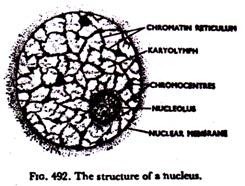ADVERTISEMENTS:
In this article we will discuss about the supercoiling of bacterial DNA.
DNA molecules exist in two states, relaxed and supercoiled. A relaxed state of DNA molecule is one in which the exact number of turns of the helix can be predicted by calculating the number of base pairs, whereas when the relaxed DNA molecules is highly twisted to accommodate itself in a little space the state is called supercoiled.
The example of Escherichia coli makes clear why relaxed DNA molecule enters into the supercoiled state. The DNA of E. coli in its relaxed state becomes more than 1 mm in length, about 400 times longer than the E. coli cell itself. How can so much DNA be packed into such a little space of E. coli cell? Nature has solved this problem by imposing a kind of ‘high order’ structure on the DNA molecule.
ADVERTISEMENTS:
In this structure the double-stranded helical DNA is further highly twisted employing the process called supercoiling, and is easily packed within E. coli cell. The supercoiled DNA molecule remains under torsion almost similar to the added tension to a rubber band that occurs when it is twisted.
DNA molecule supercoils in either a positive or negative direction; it is the negative supercoiling that predominantly operates in all non-hyperthermophilic organisms in nature. In negative supercoiling, the DNA molecule is twisted about its axis in the opposite direction from that of the right-handed double helix.
DNA molecule can be alternately supercoiled and relaxed. It is because the supercoiling is necessary for packaging the DNA into the bacterial cell and relaxing is necessary for the replication of DNA. Fig. 5.35 shows how supercoiling takes place in a relaxed covalently closed circular dsDNA molecule, and it also shows how a supercoiled DNA molecule becomes relaxed one.
ADVERTISEMENTS:
Supercoiling in bacterial and most archaeal DNA is carried out with the help of an enzyme called DNA gyrase, which is a type of enzyme called a topoisomerase, particularly a topoisomerase II.
The process completes via several steps:
(i) One strand of circular relaxed DNA is laid over the other,
(ii) Laiding one part over the other results in contact between the helix in two places, and DNA gyrase (topoisomerase II) makes a double-strand break (nick) in the region of contact at one place, and(3) the broken (nicked) double-strand is resealed on the opposite side of the intact strand resulting in supercoiling in DNA molecule.
 Supercoiling in DNA molecule removed by the action of another enzyme called topoisomerase I. This enzyme introduces a single-strand break (nick) in the supercoiled DNA and causes the rotation of one single- strand of the double-strand DNA around the other resulting in the return of supercoiled state of DNA to the relaxed state.
Supercoiling in DNA molecule removed by the action of another enzyme called topoisomerase I. This enzyme introduces a single-strand break (nick) in the supercoiled DNA and causes the rotation of one single- strand of the double-strand DNA around the other resulting in the return of supercoiled state of DNA to the relaxed state.
However to prevent the entire bacterial DNA from becoming relaxed every time a break (nick) is made, the DNA contains supercoiled domains (Fig. 5.36). Actually, the double-stranded bacterial DNA is arranged not in one supercoil but in several supercoiled domains.
In E. coli over 50 supercoiled domains are reported to exist, each of which is thought to be stabilized by binding to specific proteins. However, a nick in one strand of double-stranded DNA in one of these domains does not allow DNA to relax in other domains.

